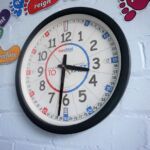
5 ways to use learning clocks in the classroom
Whether you are introducing time as a concept to young children, or making sure that your students can understand time through real-world examples, learning clocks are an excellent time-teaching tool. Learning clocks not only help children tell the time, but are also an effective way to introduce maths concepts such as fractions, addition and subtraction.
If you are searching for useful resources and practical tips to make the most of the learning clocks in your classroom, read on.
Time teaching
Our colourful, engaging classroom learning clocks are an excellent tool for introducing the concept of time to students. These clocks are designed to include all the information that a child needs to learn to tell time, including clearly-marked minutes, ten-minute blocks, and ‘past/to’ indicators. These straightforward visuals make it easier for children to understand and engage with the concept of time, and these time-telling skills can subsequently be applied to many mathematical activities. This can include addition and subtraction, as pupils can use the clock to add and subtract by counting minutes and hours. For example, if it is currently 10 past the hour, you can ask the children to add five minutes, which is easily achieved on our clocks.
Link to the curriculum
Our learning clocks come with curriculum notes printed on the back, making it easier for you to deliver a detailed and accessible time-telling demonstration that is linked to the curriculum. This ensures that you are teaching your students time in a way that is consistent with the expectations of their education.
The school day
Another effective way to use our learning clocks in the classroom is to link time-telling activities to the school day. Young children are more likely to engage with a concept if they can see how it relates to their own experiences, and using the clock to demonstrate their own timetable is an effective time-teaching strategy. This can be done by demonstrating when lunchtime, breaktime, or lessons begin and end, as well as encouraging them to tell the time of these scheduled activities themselves.
Pair with games
Using learning clocks as part of an educational game is another effective way to engage your students and in learning to tell time. Our TwinTime cards are perfect for this, as you set a time and ask your pupils to replicate it on their own cards, with space for them to also write in the analogue or digital time.
There are several different ways to make this game more engaging and challenging, including having the pupils work in pairs or small groups to see who can replicate the time the fastest, or who can get the most correct answers in a set amount of time. This makes the challenge of learning to tell the time a collaborative and engaging activity that can be shared with friends.
Support students with dyscalculia
For students with dyscalculia, learning to tell the time can be particularly challenging. If you have pupils with dyscalculia in your classroom, then our learning clocks are an excellent resource to support these students with minimal differentiation. The colourful, clear designs of our clocks break down the concept of time into a straightforward pattern that makes it much easier for children with dyspraxia to engage with time and numbers.
Once your students are comfortable with the basics, you can start to introduce more complex concepts, such as fractions and time zones, with our accessible designs. To support students with dyscalculia, it’s important to be patient and to provide plenty of opportunities for practice and reinforcement, which is made easy with our range of classroom resources.
Conclusion
By linking the clock to the curriculum, incorporating the students timetables, pairing it with games, and supporting students with dyscalculia, you can ensure that your students learn to tell the time in a fun and interactive way. By utilising a learning clock in your classroom, your students can develop their time-telling skills while also engaging in teamwork, friendly competition, physical activity, and memory improvement.
Why not try using learning clocks in your classroom today and see the difference they can make for your students.
